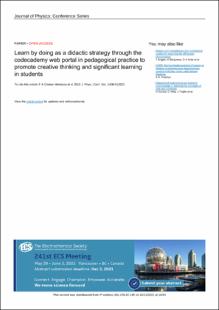| dc.contributor.author | GALLARDO PÉREZ, HENRY DE JESÚS | |
| dc.contributor.author | Gómez Mendoza, F A | |
| dc.contributor.author | Villamizar Jaimes, D | |
| dc.date.accessioned | 2021-11-10T16:13:44Z | |
| dc.date.available | 2021-11-10T16:13:44Z | |
| dc.date.issued | 2019-11-26 | |
| dc.identifier.uri | http://repositorio.ufps.edu.co/handle/ufps/845 | |
| dc.description.abstract | The work developed is action research type, framed in the qualitative paradigm. It designs a didactic strategy for the development of a different pedagogical practice to the traditional one that allows a greater autonomy in the student during the learning process, since the apprehension of knowledge is done in a more personal and practical way. The didactic proposal is developed from the diagnosis of the student's creativity and their ability to interact with academic platforms. Its implementation allows the student to learn by doing in a process of trial, error and correction in order to promote creative thinking while achieving meaningful learning. | eng |
| dc.format.mimetype | application/pdf | spa |
| dc.language.iso | eng | spa |
| dc.publisher | Journal of Physics: Conference Series | spa |
| dc.relation.ispartof | Journal of Physics: Conference Series | |
| dc.rights | Content from this work may be used under the terms of the Creative Commons Attribution 3.0 licence. Any further distribution of this work must maintain attribution to the author(s) and the title of the work, journal citation and DOI. Published under licence by IOP Publishing Ltd | eng |
| dc.source | https://iopscience.iop.org/article/10.1088/1742-6596/1408/1/012025/meta | spa |
| dc.title | Learn by doing as a didactic strategy through the codecademy web portal in pedagogical practice to promote creative thinking and significant learning in students | eng |
| dc.type | Artículo de revista | spa |
| dcterms.references | Depablos L 2016 El Twitter y la Web 2.0 como para la enseñanza de la sociopolítica en el doctorado en educación Revista Heurística 19 53 | spa |
| dcterms.references | Ministerio de Educación Nacional (MEN) 2008 Ser competente en tecnología ¡una necesidad para el desarrollo (Ministerio de Educación Nacional: Colombia) | spa |
| dcterms.references | Organización de las Naciones Unidas para la Educación, la Ciencia y la Cultura (UNESCO) 2005 Formación docente y las tecnologías de información y comunicación (Santiago de Chile: Organización de las Naciones Unidas para la Educación, la Ciencia y la Cultura) | spa |
| dcterms.references | Ahedo J and Danvila I 2014 Las nuevas tecnologías como herramientas que facilitan la educación formativa en la educación (Guadalajara: Instituto Tecnológico y de Estudios Superiores de Monterrey) | spa |
| dcterms.references | Morales V 2013 Desarrollo de competencias digitales docentes en la educación básica Revista de Innovación Educativa 5 88 | spa |
| dcterms.references | Esquivias M T 2004 Creatividad: definiciones, antecedentes y aportaciones Revista Digital Universitaria 5 2 | spa |
| dcterms.references | Ausubel D, Novak J and Hanesian H 1983 Psicología educativa. Un punto de vista cognoscitivo (México: Trillas) | spa |
| dcterms.references | Hernández R, Fernández C and Baptista M 2014 Metodología de la investigación, 6 edición (México: MCGraw-Hill) | spa |
| dcterms.references | Gallardo H, Vergel M and Villamizar F 2018 Investigación intervención y enfoque multimétodo en ciencias humanas y educación matemática Logos Ciencia y Tecnología 9 84 | spa |
| dcterms.references | Rojas B 2014 Investigación cualitativa (Caracas: Universidad Pedagógica Experimental Libertador) | spa |
| dcterms.references | Gimeno J and Pérez A 1992 Comprender y transformar la enseñanza Historia y Comunicación Social 1 338 | spa |
| dcterms.references | Penagos J and Aluni R 2000 Preguntas más frecuentes sobre creatividad Revista Psicología 1 Edición Especial | spa |
| dcterms.references | Zuluaga O 1979 Colombia: Dos modelos de su práctica pedagógica durante el siglo XIX (Medellín: Universidad de Antioquia) | spa |
| dcterms.references | Martínez A 2012 Práctica pedagógica: Historia y presente de un concepto en práctica pedagógica: Perspectivas teóricas (Bogotá: ECOE) | spa |
| dcterms.references | Waisburd G 2009 Pensamiento creativo e innovación Revista Digital Universitaria 10 2 | spa |
| dcterms.references | De Bono E 1994 El Pensamiento creativo: el poder del pensamiento lateral para la creación de nuevas ideas (México: Paidós) | spa |
| dc.identifier.doi | 10.1088/1742-6596/1408/1/012025 | |
| dc.relation.citationedition | Vol.1408 No.1.(2019) | spa |
| dc.relation.citationendpage | 6 | spa |
| dc.relation.citationissue | 1 (2019) | spa |
| dc.relation.citationstartpage | 1 | spa |
| dc.relation.citationvolume | 1408 | spa |
| dc.relation.cites | Mendoza, F. G., Pérez, H. G., & Jaimes, D. V. (2019, November). Learn by doing as a didactic strategy through the codecademy web portal in pedagogical practice to promote creative thinking and significant learning in students. In Journal of Physics: Conference Series (Vol. 1408, No. 1, p. 012025). IOP Publishing. | |
| dc.relation.ispartofjournal | Journal of Physics: Conference Series | spa |
| dc.rights.accessrights | info:eu-repo/semantics/openAccess | spa |
| dc.rights.creativecommons | Atribución 4.0 Internacional (CC BY 4.0) | spa |
| dc.type.coar | http://purl.org/coar/resource_type/c_6501 | spa |
| dc.type.content | Text | spa |
| dc.type.driver | info:eu-repo/semantics/article | spa |
| dc.type.redcol | http://purl.org/redcol/resource_type/ART | spa |
| oaire.accessrights | http://purl.org/coar/access_right/c_abf2 | spa |
| oaire.version | http://purl.org/coar/version/c_970fb48d4fbd8a85 | spa |
| dc.type.version | info:eu-repo/semantics/publishedVersion | spa |










